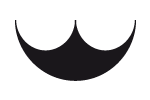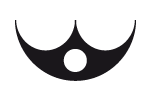In its typical form, the pelta resembles a half moon or a small epsilon. One large semi-circle has two concave indentations in its straight side in the form of smaller semi-circles. In this way three points arise which may be shaped in various ways (Fig. 3).
 |
The middle point (the so-called apex or middle ending) stands out visually in comparison to the two external points (so-called “handles” or “endings”), not least because it features the most ornamentation. For this reason, the shape of the middle ending will be the starting point for the following classification.
Other criteria are the colour and shape of the main pelta body, though these show relatively little variation. The inner surface (“belly”) and convex surface (“back”) are very seldom the object of ornamentation.
The most common pelta type found in Greece features three upwardly tapered points and appears in a dark colour (usually blue or black) on a white background. It’s unusual to find light peltae on a dark background (Fig. 4).
 |
Frequently the peltae are framed by a dark contour line, left blank white within or filled with a light colour (Fig. 5).
 |
On a mosaic from Sparta a small, lightly coloured circle is situated in a dark pelta (Fig. 6).
 |
It wasn’t possible to investigate and compare the exact dimensions of pelta ornamentations on mosaics. This might have provided information about whether certain formats and diameters were prescribed by templates or written guideliness.